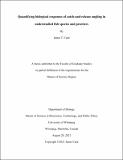| dc.contributor.author | Card, Jamie T. | |
| dc.date.accessioned | 2021-08-24T21:12:13Z | |
| dc.date.available | 2021-08-24T21:12:13Z | |
| dc.date.issued | 2021-08-20 | |
| dc.identifier.citation | Card, Jamie T. Quantifying biological responses of catch-and-release angling in understudied fish species and practices; A thesis submitted to the Faculty of Graduate Studies in partial fulfilment of the requirements for the Master of Science Degree, Department of Biology, Master of Science in Bioscience, Technology, and Public Policy, University of Winnipeg. Winnipeg, Manitoba, Canada: University of Winnipeg, 2021. DOI: 10.36939/ir.202108241604. | en_US |
| dc.identifier.uri | https://hdl.handle.net/10680/1966 | |
| dc.description.abstract | Many catch-and-release angling events involve air exposure and exhaustive exercise that elicit a physiological stress response, and depending on a variety of factors, delayed mortality is a possible outcome. There have been ample studies in this area, however, significant gaps exist in the literature for species that are targeted by more specialized anglers, such as freshwater drum (Aplodinotus grunniens). I quantified physiological and reflex responses in freshwater drum following angling, across seasons. Once a fish was on the line, the fight duration and time exposed to air were varied to account for differences in angler skill level (fight time range: 5 s to 2 min; air exposure range: 20 s to 3 min). Location and severity of injury were determined, blood biopsies were taken to quantify physiological stress, and reflex impairment was assessed. Thirtyone percent of fish captured were deeply hooked in the esophagus tissue. Freshwater drum experienced a disruption in homeostasis as blood glucose, plasma cortisol and plasma lactate increased significantly from baseline values following angling. Additionally, seasonal differences were observed for blood glucose and plasma cortisol as higher values were observed in the summer when compared to the spring. The ‘orientation’ reflex was the most frequently impaired (29 % of fish lacked this reflex), but impairment did not differ seasonally. Because freshwater drum have the largest latitudinal range of any North American freshwater fish and are being targeted more frequently by anglers as of late, it is important to fill this knowledge gap regarding their responses to angling events to develop best practices for anglers to promote conservation. The wide distribution of freshwater drum may also make them a candidate model species for addressing the convergence between assessing the impacts of catch-and-release angling and other environmental issues facing freshwater fishes, such as climate change. | en_US |
| dc.description.sponsorship | NSERC CGS-M | en_US |
| dc.language.iso | en | en_US |
| dc.publisher | University of Winnipeg | en_US |
| dc.rights | info:eu-repo/semantics/openAccess | en_US |
| dc.subject | Recreational angling | en_US |
| dc.subject | Stress response | en_US |
| dc.subject | Seasonal effects | en_US |
| dc.subject | Fisheries conservation | en_US |
| dc.subject | Ice-angling | en_US |
| dc.title | Quantifying biological responses of catch-and-release angling in understudied fish species and practices | en_US |
| dc.type | Thesis | en_US |
| dc.description.degree | Master of Science in Bioscience, Technology, and Public Policy | en_US |
| dc.publisher.grantor | University of Winnipeg | en_US |
| dc.identifier.doi | 10.36939/ir.202108241604 | en_US |
| thesis.degree.discipline | Bioscience, Technology, and Public Policy | |
| thesis.degree.level | masters | |
| thesis.degree.name | Master of Science in Bioscience, Technology, and Public Policy | |
| thesis.degree.grantor | University of Winnipeg | |

